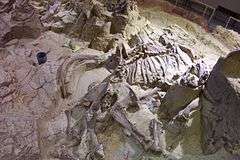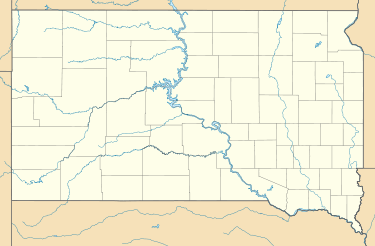Mammoth Site, Hot Springs
| Mammoth Site | |
|---|---|
 | |
 Map of South Dakota | |
| Location | Hot Springs, South Dakota |
| Coordinates | 43°25′29″N 103°28′59″W / 43.42471°N 103.48313°WCoordinates: 43°25′29″N 103°28′59″W / 43.42471°N 103.48313°W |
| Designated | 1980 |
| Official website | |
The Mammoth Site is a museum and paleontological site near Hot Springs, South Dakota. It contains the remains of fauna and flora preserved by entrapment in a karst sinkhole during the Pleistocene era. Mammoth bones were found at the site in 1974, and a museum and building enclosing the site were established. The museum now contains an extensive collection of mammoth remains. Research and excavations at the site are ongoing.
Formation

About 26,000 years ago the cavern at the site collapsed. The resulting steep-sided hole, about 65 feet deep, was 120 by 150 wide at the surface.[1] Warm artesian-fed spring waters created a pond that was attractive to wildlife. Findings at the site include the remains of megafauna such as Giant short-faced bears along with those of shrub oxen, American camel, llama, wolves, coyotes, birds, minks, ferrets, prairie dogs, voles, and moles.[2][3] Invertebrate discoveries include several species of clams, snails, and slugs.[4]
Over the course of the next 350 to 700 years, the hole filled with sediments and mammoth remains.[1] The remains of the living organisms in the site are not technically fossils, since they were not mineralized but preserved by the clay and coarse sand that accumulated within the sinkhole.[5] As of 2012, at least 61 individual mammoths had been identified.[6][7] The majority of the mammoth remains have been identified as those of Columbian Mammoths, although the remains of three Woolly mammoths have been found as well.[8]
Mammoths that slipped into the hole found it difficult to escape. Researchers measuring the pelvic bones of the remains have determined that most of the victims were young males.[2] A hypothesis drawn from observations of modern elephants' matriarchal societies, in which these group members are expelled, concludes that this group was inclined to the risk-taking behavior that led to their entrapment.[2]
Museum
In 1974, a construction worker, George Hanson, unearthed unusual bones while the area was being prepared for a new subdivision.[2][9] His son recognized one of the finds as a mammoth tooth.[2] The landowner agreed to further investigation, and a complete skull and tusk were found in 1974.[2] Donations, some made by local citizens, along with the work performed by amateur and professional excavators, led to its status as a museum, and it was designated a National Natural Landmark in 1980.[2][10] Initially the finds were mapped on a string grid; since then the mapping systems have increasingly relied on computerized technologies.[7]
The Mammoth Site is now a 501(c)-3 non-profit organization. The museum is open to the public. Earthwatch volunteers participate in excavations during July.[11] The museum's visiting scientists have included specialists from Mexico, Italy, Netherlands, Great Britain, Russia, and Germany.[9] The museum also houses a collection of Clovis and Folsom artifacts[6] and sponsors outreach programs for students from elementary to graduate-school levels.[12]
References
- 1 2 "Mammoth Site Geology". The Mammoth Site of Hot Springs, South Dakota. Retrieved 2009-07-27.
- 1 2 3 4 5 6 7 Agenbroad, Larry D. (1997). "Thisland/South Dakota: mammoth site". Natural History Magazine. Retrieved 2009-07-26.
- ↑ "South Dakota Ice Age mammals". Northern Illinois University. Retrieved 2010-10-15.
- ↑ "A Rare Glimpse - The following is a partial list of invertebrate remains recovered from the Mammoth Site.". The Mammoth Site of Hot Springs, South Dakota. Retrieved 2009-07-29.
- ↑ "Bone distribution and diagenetic modifications at the Mammoth Site of Hot Springs, South Dakota, USA". The Geological Society of America. Retrieved 2009-07-26.
- 1 2 "The Mammoth Site Exhibits". The Mammoth Site of Hot Springs, South Dakota. Retrieved 2009-07-26.
- 1 2 "It's All about Context - Remapping mammoth bone bed with ArcGIS". ESRI. Retrieved 2009-07-26.
- ↑ "Mammoth Origins, Species, Heights & Weights, Teeth, and Tusk Information". The Mammoth Site of Hot Springs, South Dakota. Retrieved 2009-07-26.
- 1 2 "More than 26,000 years ago, large Columbian and woolly mammoths were trapped and died in a spring-fed pond near what is now the southwest edge of Hot Springs, South Dakota.". The Mammoth Site of Hot Springs, South Dakota. Retrieved 2009-07-26.
- ↑ Muller, Joe (1996). "A mammoth discovery - Mammoth Site, Hot Springs, South Dakota - Cover Story". National Recreation and Park Association. Retrieved 2009-07-29.
- ↑ "Stand on the edge of discovery and walk where mammoths, bears, American lions and other Ice Age animals walked...". The Mammoth Site of Hot Springs, South Dakota. Retrieved 2009-07-27.
- ↑ "The Mammoth Site of Hot Springs South Dakota: Strategies for educational development in a paleontological site". Geological Society of America. Retrieved 2009-07-26.
External links
- The Mammoth Site of Hot Springs, South Dakota - official site